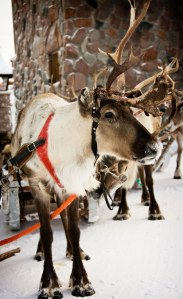
For many of us, the holiday season often brings about feelings of surprise, wonder, and especially magic. And indeed, many holiday icons are cloaked in stories of magic! Santa’s world-wide voyage, for example, is one such story, and who of course could forget the creatures that make that trip possible: his nine magic reindeer.
The original eight (Dasher, Dancer, Prancer, Vixen, Comet, Cupid, Donder and Blitzen) are based on those referred to in the 1823 poem A Visit from St. Nicholas attributed to poet Clement Clarke Moore. (The poem is also known as 'Twas the Night Before Christmas).
Rudolf the red-nosed reindeer didn’t officially join the ranks until 1939, when a children’s book of the same name was published to promote the Montgomery Ward department-store chain. Gene Autry’s original recoding of the much beloved Christmas song in 1949 further propelled the animal to holiday fame.
And while we may read the stories and sing the songs every year, have you ever thought about how much truth is hidden within this fiction? How much do we really know about Santa’s reindeer? From a scientific point of view, they may not actually be able to fly, but they are truly fascinating creatures!

In North America, reindeer are more commonly referred to as caribou (Rangifer tarandus), while reindeer is usually used in Europe and Asia, for both the wild and domesticated populations.
Staying true to the Christmas legend, these species reside all around the Arctic tundra and forest edges. According to former Canadian Museum of Nature researcher Donna Naughton and her newly published book The Natural History of Canadian Mammals, there are three types of caribou that reside in Canada: the woodland caribou (Rangifer tarandus caribou), the barren-ground caribou (Rangifer tarandus groenlandicus and Rangifer tarandus granti) and the Peary caribou (Rangifer tarandus pearyi)—each residing in their own distinctive areas in the Arctic.

According to the children’s stories, Santa’s workshop and home base are in the North Pole. Therefore, the species of caribou (reindeer) most likely referred to in these stories is the Peary caribou, given that they are the most northerly species. They are found throughout the Queen Elizabeth Islands, Prince of Wales Island, and Somerset Island—all close to the North Pole. However, this is just speculation of course, as Santa could have gotten them from anywhere!
Additionally, Naughton describes the Peary species’ colouration as “ghostly white in winter and grey-brown and white in summer”. In doing my research, many artists’ renderings of Santa’s helpers are just as she describes.

Now when it comes to the antlers, science and children’s fiction seem to differ. Unlike most deer species, both male and female caribou grow antlers. Those of adult males are much larger, but they get cast off by mid-November and won’t begin to grow back until March.
Juveniles and adult females, including pregnant ones, retain their antlers throughout the winter. Thus the females become dominant in the herd during that period. The antlers also help them defend their feeding craters during the relative scarcity of winter.
Therefore, if Santa’s reindeer were actually all male, and most of them adults, as the stories imply, they would have already lost their antlers by Christmas. Because artists always depict Santa’s sleigh being pulled by reindeer with antlers, this must mean that all his reindeer are female, and possibly even pregnant females!
Biologically, female caribou antlers are usually much smaller than those of full-grown males. Artistically, Santa’s reindeer are usually depicted with the larger antlers of males, so clearly, fiction and science just aren’t going to see eye to eye on this one!

The story of Santa and his magic reindeer is one that is much loved and has been interpreted in many different ways around the world. And while many of us scientific-minded folk may have a hard time believing in magical flying reindeer, it seems this cherished Christmas story is rooted (albeit quite loosely) in some natural history!
If you’d like to see these creatures for yourself without having to travel to the high Arctic, come to the Canadian Museum of Nature to see them featured in a beautiful diorama in our Mammal Gallery. Or, for the young at heart, try to find (miniature versions) of Santa’s reindeer hidden throughout the museum!
